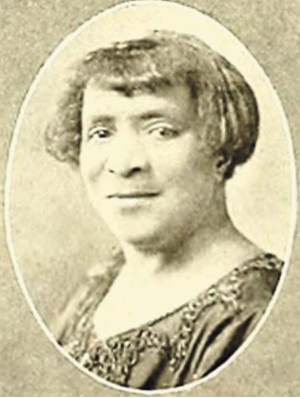Norwood, a mostly African-American neighborhood on the near southeast side of Indianapolis, bounded on the north by Prospect St., Terrace Ave. on the south, Sherman Dr. on the east and Vandeman St. on the west, takes its name from the Norwood family who farmed the area. For many years the community was outside of the Indianapolis city limits and was known as a shady spot and “moral blot on the map of Marion County” before its transformation into “a placid collection of homes…where lawbreaking is almost unknown.” This metamorphosis was attributed to the efforts of one woman, Ada Harris, the local schoolteacher.
Ada Belle Harris was born in Kentucky on August 15, 1866 to Robert Harris and Anna “Annie” Brown Harris. When she was a toddler, her mother married Lawrence Toliver of Newport, Kentucky. In 1875 Ada came to Indianapolis when her mother and stepfather relocated to the Hoosier capital, settling in the Indiana Avenue African-American neighborhood. After completing elementary school, she continued her studies at the Indianapolis High School (Shortridge High School), graduating in February 1888.
In September 1888, Harris was appointed principal and teacher at Center Township School No. 5. Located in the southeast part of Center Township in the Norwood neighborhood, School No. 5 was a one-room building at the time serving fifteen “colored” children of all ages. One of the first innovations Harris introduced that became an annual tradition was a “real Thanksgiving dinner served at the school building” prepared by the parents of the pupils. Over time, Harris became well respected by the Norwood people and a “thorough teacher, loved and honored by every child of her school.” Not only interested in her students’ “heads,” she also kept their hands busy with classes for girls in basket weaving and millinery. Harris also introduced shoe making so her pupils could repair their own dilapidated shoes and those of other Norwood residents.
Over time, the School No. 5 building was enlarged, and a growing student population eventually made it the “largest colored school in the county.” Another teacher was appointed to help Harris with the teaching duties, and in 1903 at the dedication of a new flagpole the school was named for Harriet Beecher Stowe.
In 1904, Harris organized a boys’ club — the Boy’s Lookout Club — to teach young men a “few rules of right living.” Open not only to School No. 5 boys, but to all Norwood boys, the club discussed topics like “good deportment in the home and in public places, kindness to animals, and kindred subjects.” Soon the Norwood neighborhood found “politer boys and quieter streets.” The boys contributed five cents at the club’s bi-weekly meetings, and soon enough funds, including public donations, had been raised for Harris to buy an old farmstead for a clubhouse and reading room. A large barn was converted into a gymnasium. When fire destroyed the school building and its library, Harris launched the Norwood Library Association to replace the lost volumes and donated a “small number of books as a starter.” Within two years, the “first colored library in Indianapolis” had been established on the Norwood Boys’ Club grounds with over 1,000 books.
When Norwood was annexed to the city of Indianapolis in 1912 (an act Harris led a petition effort in opposition), School No. 5 was redesignated Harriet Beecher Stowe School No. 64 with Harris continuing in her position as principal. In an attempt “to teach the children that it is the duty of all citizens to pay their taxes,” she took twenty of her students to the office of the county treasurer and the pupils arranged to pay the arrearage on their parents’ taxes. After a leave of absence to complete a course at the State Normal School (Indiana State University), Harris was appointed a teacher at Booker T. Washington School No. 17.
In addition to teaching, Harris worked with the Woman’s Improvement Club in addressing tuberculosis among blacks. Recognizing that “There seems to be a greater need for this work among Colored people than among any other race and yet we are the only race for who no provision has been made in this great fight on tuberculosis,” a “Fresh Air Mission” for blacks opened in 1905 at Oak Hill. During World War I, Harris helped organize the Norwood Civic League. She also formed the Franchise Economy Club and the Girls’ Canning Club among Norwood “colored women” for the canning of vegetables.
Although Harris had not attended college, she took summer school classes at Butler College and in 1912 she was among the first to receive a diploma from the Indianapolis Training School for Social Workers which had opened at the YWCA with lectures in “civic affairs, community problems, social treatment for social ills, economic factors in social problems, child welfare and medical sociology.” In 1920 when women received the right to vote, Harris organized a citizenship school at the Phyllis Wheatley YWCA under auspices of State Federation of Colored Women’s Clubs “in order to arouse greater interest in suffrage and give colored women a greater opportunity to learn about government, municipal and state affairs, politics, the use of the ballot, organization work among women, and public speaking.”
Harris resigned her teaching position in 1924 to complete her studies towards a degree in journalism at Butler College where she joined the Pen and Pencil Club, the Press Club, and the Woman’s League. Receiving a B.A. degree in 1926, sadly, Ada B. Harris died the following year of a paralytic stroke on September 12, 1927 at her Norwood home, 1120 Earhart St., and was buried in Crown Hill Cemetery. In her will, Ada Harris made provisions for the Indianapolis board of park commissioners to create a playground in the Norwood neighborhood and a recreational center to be known as the Ada B. Harris Recreational Center “especially for the use and benefit of colored children.”



